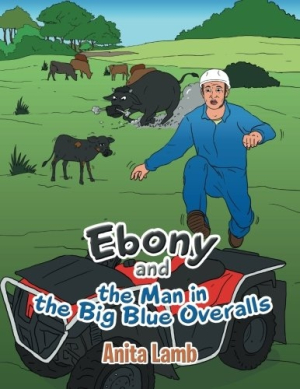
Ebony and the Man in the Big Blue Overalls
The sometimes unpleasant challenges of farm life make for a great learning experience for children.
Spring brings new challenges on the farm, and when newborn calf Ebony is forsaken by her mom, the Man in the Big Blue Overalls and his wife have to step in. Young people will learn about some of the challenges of a working farm in this bright, colorful picture book written by Anita Lamb, a farmer from New Zealand.
Bright illustrations teeming with vibrant primary colors are featured in this picture book, along with main character Ebony’s appealing doe eyes; even when caught in a swollen stream, she looks directly at readers and draws them in. On each two-page spread, there is text on one side and a full-page illustration on the other. It is puzzling as to why, in one case, the exact same illustration of Ebony being bottle-fed is used on two separate spreads.
The book can be a visual challenge because the typeface is very light and occasionally runs into the illustration of the Man in the Big Blue Overalls, who appears on the corner of each page of text. There is also a great deal of unused space on the text pages that could be better utilized with a bigger, more readable type size to balance the pages.
This picture book is aimed at helping young children learn about life on the farm. Lamb writes of the sometimes unpleasant challenges, as well as the hard work and caring attitude of the farmers toward their charges. The story is inspired by a true event on the farm run by Lamb and her husband; the author’s impeccable farming credentials make her an expert on farm life.
This is not likely a picture book that will be read by children without the help of an adult. One problem is the use of hefty words, such as “colostrum,” which is not likely in the vocabulary of the standard picture-book reader. In addition, many of the sentences are long: “The warm drink of milk was a very distant hope that was fast disappearing.” This is by no means a serious issue, however, as the book can be shared with younger people by an older reader.
Something that is more difficult to overlook is the aggressiveness of the mother cow: “Your mum is quite mad and you’ll die if I leave you out here.” This is the reality of the farm, but this concept could cause stress in sensitive younger children if they become concerned this could happen to them and their own parents. There is also an explanation of hormones causing the mother cow to behave wildly toward her calf, a situation that may cause stress if the reader’s mother has another child, and they fear this will happen with the new baby. If the book is read to a child by a caring adult who can discuss these issues, there may not be a problem.
This book will be a good choice for children who live on farms or those who wish to introduce the farming experience to their children.
Reviewed by
Lynn Evarts
Disclosure: This article is not an endorsement, but a review. The publisher of this book provided free copies of the book and paid a small fee to have their book reviewed by a professional reviewer. Foreword Reviews and Clarion Reviews make no guarantee that the publisher will receive a positive review. Foreword Magazine, Inc. is disclosing this in accordance with the Federal Trade Commission’s 16 CFR, Part 255.
